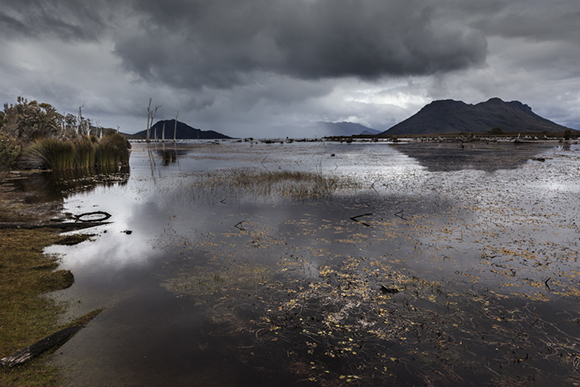Summary |
PhD Examination Exhibition |
|---|---|
Start Date |
Apr 7, 2017 12:30 pm |
End Date |
Apr 23, 2017 5:00 pm |
Venue |
Plimsoll Gallery |
Wildness and Artefact: Re-presenting the Divergent Trajectories of Lakes Gordon and Pedder.

Image credit: David R. Blühdorn, The Wetland Aspirations of the Inflowing Huon River (Pedder Impoundment)
Abstract
The Gordon River Power Development in southwest Tasmania was completed in the early 1970s, creating two large hydro-industrial impoundments: Lakes Gordon and Pedder. The Tasmanian Wilderness World Heritage Area now surrounds these impoundments.
This thesis is concerned with visually exploring the divergent evolution of the impoundments and researching wild aspects of their associated streams. It focuses on water as the dominant element in hydropower generation, and as a key agent of wildness. The thesis’ research questions address: wild aspects of water; the structural artefacts and their management regimes; their interactions with wild processes; and how these factors might advance relevant visual discourse.
The thesis’ artistic context is located in the antecedent landscape photography of Olegas Truchanas and David Stephenson in the Pedder-Gordon area, the human photography of Sebastião Salgado and the human-impacted compositions of Edward Burtynsky, as well as the aquatic imagery of Narelle Autio and Susan Derges. Historical photographic influences included the works of Carleton Watkins, Morton Allport, Charles Pratt, and Eliot Porter.
The thesis’ conceptual basis concerns humanity’s perceptions of its relationship with the extra-human world. It examines the utility of both the currently prevailing anthropocentric paradigm, and the more inclusive, ecocentric paradigm. For a theoretical background, it draws on diverse sources, including the photographic writings of John Berger, Susan Sontag, and Rebecca Solnit, the post-nature dialectics of Arturo Escobar, Bill McKibben, Val Plumwood, and Jane Bennett, and the anthropological insights of Howard Morphy and Tim Ingold. Theodor Schwenk’s and Philip Ball’s writings provide useful alternative perceptions of the diverse characteristics of water.
Multiple trips to the field locations facilitated the thesis’ investigations. In the Pedder Impoundment, the divergence was found to be attributable to water’s engineered persistence. This enabled the re-presentation of aspects of weather, dam leakage, the development of macrophyte beds, and the persistence of aseasonal wetlands. In the Gordon Impoundment, the principal driver of divergence was the market-driven withdrawal of water. This led to the visual examination of the recently dewatered littoral, which exhibited the effects of inundation and pre-impoundment logging, as well as the impoundment’s preservative powers, and its terrestrial and fluvial regenerative processes. Water’s intrinsic wildness was explored through subsurface imagery of both impoundments’ inflowing waterways.
The thesis’ outcomes comprise a suite of original photographic prints and performative works that reveal aspects of the consequences of impoundment. They also extend perceptions of the extra-human agency that is inherent in flowing water. These works contribute meaningfully to the ongoing discourse surrounding conceptions of wildness and of artefact, and their affective representation. Such outcomes are broadly applicable to the fields of landscape photography in a global context and, more specifically, to perceptions of wildness in human-altered environments such as large-scale renewable energy developments adjacent to iconic wild areas.
Exhibition opening: Fri 7 April, 5:30pm - 7:00pm
Exhibition dates: Fri 7 - Sun 23 April
Gallery Hours: Wed - Mon 12pm - 5pm during exhibitions
Closed Tuesdays and Public holidays